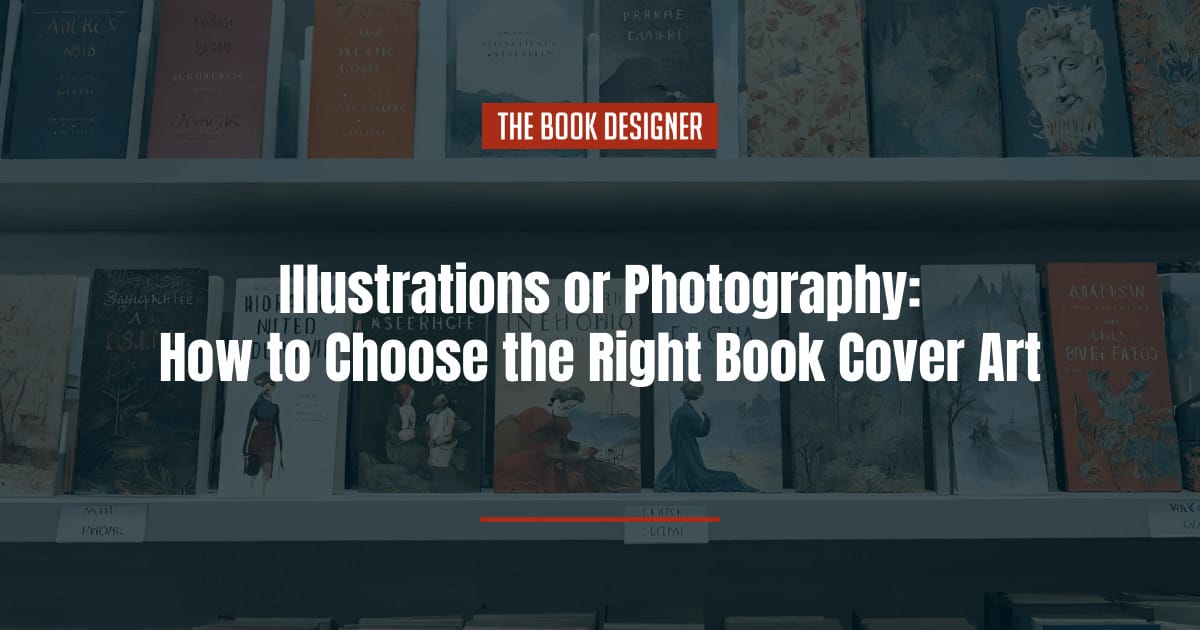Selecting the right visual elements for your book cover is a crucial aspect of the publishing process that can significantly impact your book’s appeal and marketability. Oftentimes, authors wonder whether to choose illustrations or photography for their book cover art.
Each option carries its own set of advantages and disadvantages, as we’ll see below. On one hand, illustrations allow for artistic creativity and independent interpretation of your narrative. On the flip side, photography brings a sense of authenticity and realism, capturing moments that resonate with your story’s essence.
In this article, we’ll delve into the pros and cons of using illustrations or photography for your book cover art. Understanding the nuances of these visual elements will help you make informed decisions that align with your book’s themes and target audience.
Learn everything you need to know about using illustrations or photography for your book cover art:
Pros of Using Illustrations for Your Book Cover Art
Books like Tomi Adeyemi’s Children of Blood and Bone, and Abbi Waxman’s The Bookish Life of Nina Hill have stunning illustrated book covers that not only look unique but invoke the emotions the author wants readers to feel.

Using illustrations for your book cover art can offer various advantages. Here are five of them:
1. Originality
Because illustrations are often custom-made, they allow you to create a unique and original cover that not only stands out from the crowd, but has a distinct identity, authenticity, and aesthetic appeal.
Unlike stock photos or generic designs, custom illustrations capture the essence of your book in a way that is specific to your story, making it instantly recognizable and memorable for potential readers.
2. Versatility in Style
Book cover illustrators offer a wide range of artistic styles, from minimalist and abstract to detailed and realistic. This versatility allows you to choose a style that complements the genre and tone of your book, appeals to diverse demographics, and creates a visual identity that resonates with your target audience and enhances the overall aesthetic appeal of your cover.
3. Timelessness
Well-executed illustrations often have a timeless quality that can endure over the years. Unlike photographic trends that may become outdated, a carefully crafted illustration can maintain its relevance, ensuring that your book cover remains appealing to the eye, resonates with readers across different eras, and stays current for an extended period.
4. Consistency Across Series
If your book is part of a series, using illustrations for the cover art allows for consistency in visual branding. A consistent illustrative style across multiple books in a series creates a cohesive and recognizable look, which helps readers easily identify with your books, reinforces genre identity and readers’ expectations, and encourages them to explore more titles within the series.
5. Standout Thumbnail
Cons of Using Illustrations for Your Book Cover Art
While there are many advantages to using illustrations for book covers, there are also potential drawbacks. Here are five of them:
1. Expensive
Custom illustrations can be expensive and time-consuming to produce. Hiring a skilled illustrator and actively participating in the creative process can take significantly longer than using stock photos or pre-made designs. The book cover design process generally takes a few weeks to a couple of months to complete (from ideation to execution).
The estimated budget for a simple book cover design is between $100 and $500, while an experienced designer could charge between $500 and $2,000 (or even more). If you’re on a tight budget or have a strict timeline, the cost and time investment required for illustrations can be a significant drawback.
Even if you have illustration skills and you want to design your book cover yourself, you’ll have to spend money on software tools, which can be expensive.
2. Misalignment With Reader Imaginations
Readers often form their mental images of characters and scenes as they read. If the illustration on a book cover deviates significantly from these individual interpretations, it may create a dissonance between the reader’s expectations and the actual content of the book—which can lead to disappointment or confusion.
3. Genre Suitability
Not all genres are well-suited to illustrated covers. For instance, certain non-fiction or literary genres might benefit more from a minimalist, symbolic, or photographic cover design. Inappropriate illustration styles may misrepresent the book’s tone or give potential readers the wrong impression of its content.
4. Niche Audience Appeal
While illustrations can be tailored to a specific target audience, there’s a risk of alienating readers outside that niche. If the illustration is too specific or appeals to a small demographic, in that case, it may limit the book’s potential reach and exclude readers who might otherwise enjoy the book.
5. Accessibility
Highly complex or intricate illustrations may not be easily distinguishable for individuals with visual impairments and can hinder the ability of certain readers to understand and/engage with your book cover.
Pros of Using Photography for Your Book Cover Art
Popular non-fiction books like Viola Davis’ Finding Me and Prince Harry’s Spare have poignant photographs of the authors taking center stage on the book covers.

But using photography on your book cover isn’t limited to pictures of people. It can also be pictures of streets, landscapes, and even objects as we see in Stephen King’s Under the Dome.

Using photography for your book cover art has many upsides. Below are some of them:
1. Authenticity and Realism
Your book cover can convey a sense of authenticity and realism through photography. By using actual images, you can provide readers with a visual representation of real-life elements in your book, making it easier for them to connect with your book’s content emotionally.
Authentic photography can also lend credibility to your narrative, especially for nonfiction or stories grounded in reality.
2. Versatility Across Genres
Photography is a versatile medium that can be adapted to suit various genres, including mystery, romance, science fiction, and historical fiction.
The right photograph can capture the mood, setting, or key elements of your story, which makes photography a great choice for a book cover, no matter the niche or theme.
3. Immediate Visual Impact
With its ability to freeze a moment in time, photography allows you to create a striking and visually arresting book cover that grabs the attention of potential readers in a crowded bookstore or online marketplace, enticing them to explore the book further. This visual impact can make all the difference between someone buying your book immediately or scrolling past without a second glance.
4. Professionalism
High-quality visuals are often associated with well-crafted content, and using professionally shot and edited photographs for your book cover can signal to readers that your work is of a certain standard. This is particularly important for establishing credibility and trust in the competitive book market.
5. Adaptability for Series
Using a consistent photographic style allows you to create a cohesive visual theme for a book series while allowing for a thematic evolution. Consistent elements such as a recurring character or a distinctive visual element can create a trend that links all the photography-based book covers, helping readers recognize a book that belongs in your series.
Using consistent photographic themes across your book covers can also create a cohesive visual brand identity that helps readers recognize the titles you wrote. This enhances your overall author image and builds a sense of familiarity among your readers.
6. Time- and Cost-Efficiency
Compared to custom illustrations, professional photography can be a more cost-effective and time-efficient option. Hiring a photographer for a specific shoot can be more budget-friendly, and the availability of diverse stock photo libraries provides a wide range of options, which can reduce the duration of the creative process.
Cons of Using Photography for Your Book Cover Art
While photography has its merits, it also has some downsides to using it for your book cover art. Below are some of them:
1. Risk of Generic Design
Stock photography, especially unpaid images that are widely used, can result in a generic or cliché design. If the photograph is not carefully chosen or lacks originality, your book cover may blend in with—rather than stand out from—others in the same genre. This can hinder your book’s ability to attract attention, which will affect sales.
2. Limited Customization
While photography captures real-world scenes, it doesn’t offer the same level of customization as illustrations. Because of this, there is a risk of creating covers that feel formulaic or fail to accurately represent the nuance of your narrative. For instance, if your book requires highly specific or fantastical elements that are challenging to find in existing photographs, you might face limitations in achieving a cover that precisely aligns with the unique aspects of your story.
3. Inability to Depict Abstract Concepts
While photography is a powerful medium for capturing tangible subjects and themes, it may not effectively convey abstract or conceptual themes present in your book. Unlike illustrations, which can depict symbolic representations, metaphors, or fantasy elements, photography is often grounded in reality. This can be a drawback for books that explore complex or non-literal ideas.
4. Copyright and Licensing Issues
When using photography for your book cover art, you need to pay attention to copyright and licensing—especially if you’re using stock photos. If the image on your book cover isn’t properly licensed, you could face legal challenges. It’s crucial to adhere to licensing agreements and ensure that you have the right to use the chosen image for commercial purposes.
5. Evolving Trends and Visual Aging
Like any visual medium, photographic styles can be influenced by trends that may change over time. A cover designed with a trendy photographic style may risk appearing dated as aesthetics evolve. What may be fashionable and eye-catching today might not have the same impact in the future, potentially diminishing your book’s appeal to contemporary audiences.
Choosing Between Illustrations or Photography for Your Book Cover Art
To choose whether to use illustrations or photography for your book cover art, you’ll need to consider the specific requirements of your project, your book’s genre, and your target audience’s expectations.
Generally, autobiographies have a picture of the author on the book cover, which is appropriate because the author is the book’s focal point. Fiction genres, such as romance and Young Adult, often have illustrations on the book cover. Some genres, however, such as mystery, may use photographs of landscapes, settings, and objects to give a haunting, yet poignant, glimpse into the book’s contents.




